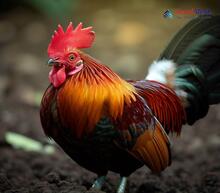Bird lovers and scientists alike have long been fascinated by the Gallus genus, a group of birds belonging to the pheasant family. Known for their gorgeous feathers, unique crowing, and intriguing evolutionary past, these birds have become an engaging topic to explore. In this article, we'll take a closer look at the Gallus genus's evolutionary tree and learn about its remarkable presence across Nepal's varied landscape.
Unveiling the Gallus Evolutionary Tree
The evolution of the Gallus genus takes us on an enchanting journey through millions of years. This genus is home to four main species – the Red Junglefowl (Gallus gallus), the Green Junglefowl (Gallus varius), the Grey Junglefowl (Gallus sonneratii), and the Ceylon Junglefowl (Gallus lafayettii). It is thought that jungle fowls' ancestors roamed within the Indian subcontinent around 5 million years ago. As time passed, populations diverged and gave way to speciation events, resulting in the incredible birds we know today. The Red Junglefowl is recognized as the wild ancestor of today's domesticated chickens.
Grey and Ceylon Junglefowl mainly reside in India and Sri Lanka, while the captivating Green Junglefowl, with its shimmering green hues, calls Java and nearby Indonesian islands home.
Experiencing Gallus Genus Birds in Nepal
Nepal's diverse terrain offers countless opportunities to observe members of the Gallus genus flourishing in various environments. Most prominently, Red Junglefowls can commonly be found within Nepalese territories. These eye-catching birds live in Nepal's tropical forests, Himalayan foothills, and well-known national parks like Chitwan and Bardia. With their vivid red feathers and unmistakable crowing, the Red Junglefowl is hard to miss. The Gallus genus birds, particularly the Red Junglefowl, signify a healthy ecosystem in Nepal. They play vital roles in managing insect populations, dispersing seeds, and enhancing Nepal's vast biodiversity.
The Gallus genus gives us a glimpse into the captivating world of bird evolution and adaptation. By understanding their evolutionary history and appreciating their presence across Nepal's diverse landscapes, we deepen our comprehension of their importance and the overall impact of preserving these extraordinary birds. As we continue uncovering more about the Gallus genus and their evolution tree, we contribute to ensuring their existence for future generations.




